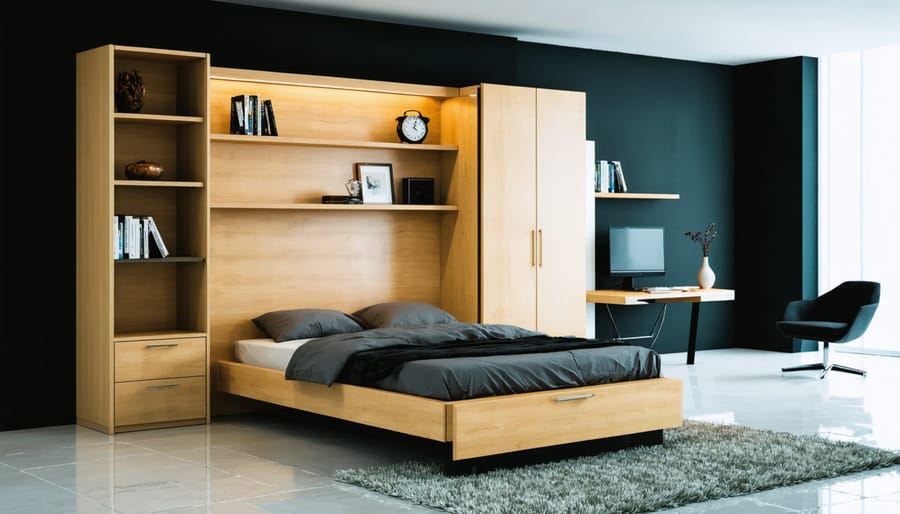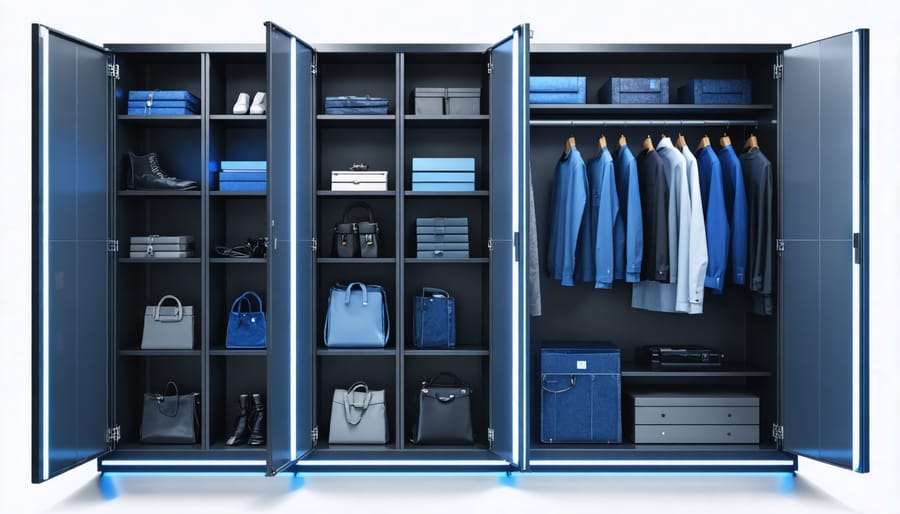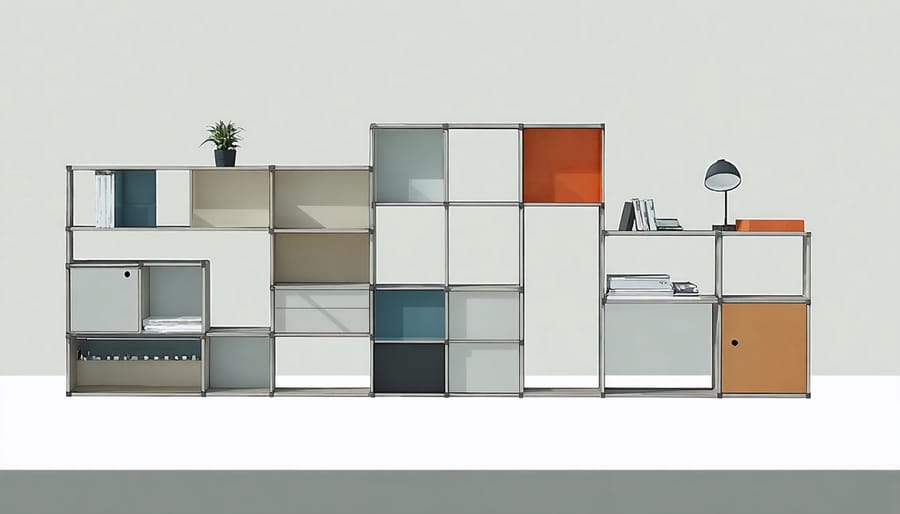Transform your cramped living space into a tech-savvy sanctuary with today’s innovative smart furniture solutions. Multi-functional pieces that respond to voice commands, fold away at the touch of a button, and adapt to your daily needs aren’t just futuristic concepts—they’re reshaping how we live in compact spaces right now. From Murphy beds that descend from stylish wall units to coffee tables that expand into full dining surfaces, smart furniture doesn’t just make your room look bigger—it revolutionizes how you use every square inch.
Modern space-saving furniture has evolved beyond simple fold-out designs to incorporate smart home technology, automated storage solutions, and modular systems that adapt to your changing needs. Whether you’re furnishing a studio apartment, a tiny home, or simply maximizing a small room, these intelligent designs offer the perfect blend of functionality and style without compromising on comfort or aesthetics. Let’s explore how smart furniture is redefining small-space living and discover practical solutions that can transform your compact space into an efficient, comfortable haven.
Transforming Furniture: The Space-Saving Superheroes
Beds That Disappear During the Day
When space is at a premium, your bed doesn’t have to be a permanent fixture. Modern Murphy beds and wall beds offer ingenious solutions that transform your sleeping area into usable living space during daylight hours. These clever designs have come a long way from their creaky predecessors, now featuring smooth mechanisms and stylish finishes that complement any décor.
The classic Murphy bed remains a popular choice, folding vertically into a wall cabinet that can double as a bookshelf or storage unit. Some models even incorporate desks or tables that automatically position themselves as the bed folds away. For studio apartments, consider a horizontal wall bed that tucks away beneath shelving units, perfect for rooms with lower ceilings.
Cabinet beds offer another smart alternative, concealing a full-sized mattress in what appears to be a standard dresser or credenza. When closed, they provide a surface for décor or TV placement, making them ideal for guest rooms that serve multiple purposes.
For the tech-savvy homeowner, smart beds with automated lifting mechanisms are gaining popularity. These systems can be controlled via smartphone apps, making the transformation from bedroom to living space effortless. Many come with built-in LED lighting and USB charging ports, adding functionality without sacrificing style.
Pro tip: When shopping for a disappearing bed, pay attention to the mattress specifications. Most systems work best with specific mattress types and thicknesses to ensure smooth operation and proper storage.

Tables That Transform
When space is at a premium, adaptable tables become your best friends. Today’s transforming tables are engineering marvels that seamlessly shift between functions, making every square inch count. Take the innovative butterfly-leaf dining table, which expands from an intimate two-seater to a dinner party-ready surface that comfortably seats eight. When not in use, the leaves fold discreetly inside the table, maintaining a sleek profile.
Coffee tables have evolved far beyond simple surfaces for magazines and remote controls. Modern designs feature lift-top mechanisms that raise to create an instant workspace, perfect when you need to design the perfect workspace without dedicating an entire room to it. Look for models with built-in storage compartments to keep your essentials organized and hidden from view.
Smart options include nesting table sets that tuck away when not needed, and console tables that transform from slim hallway pieces into full-sized dining tables. The latest designs incorporate charging stations and LED lighting, making them as functional as they are space-efficient.
Pro tip: When shopping for transforming tables, prioritize smooth mechanisms and sturdy construction. Test all moving parts several times, and ensure locking mechanisms are secure. Remember, the best transforming furniture should be as reliable in its expanded state as it is in its compact form.
Tech-Integrated Storage Solutions
App-Controlled Organizing Systems
Transform your storage spaces into tech-savvy organizational hubs with app-controlled systems that bring convenience to your fingertips. These modern solutions are among the most ingenious storage hacks available today, combining smart technology with practical design.
Popular options include motorized closet systems that rotate your clothes with a simple tap on your smartphone, making every inch of vertical space count. Smart drawers and cabinets equipped with LED lighting activate automatically when opened, while integrated inventory apps help you track stored items and their locations.
Many of these systems feature customizable compartments that you can adjust through your device, perfect for adapting to changing storage needs. Some even come with built-in sensors that monitor humidity levels to protect your belongings and alert you when conditions aren’t optimal.
For kitchen spaces, app-controlled pantry systems can track expiration dates and generate shopping lists based on your inventory. Smart shelving units with weight sensors can automatically reorder items when supplies run low, ensuring you never run out of essentials.
The best part? These systems often integrate with your existing smart home setup, allowing you to control everything from lighting to temperature through a single interface. While the initial investment might be higher than traditional storage solutions, the convenience and space optimization they offer make them worth considering for modern small-space living.

Hidden Tech Compartments
In today’s tech-driven world, keeping our devices charged and cables organized is crucial. That’s where hidden tech compartments in furniture come to the rescue, offering seamless solutions that maintain your space’s clean aesthetic while keeping functionality at your fingertips.
Modern furniture designers have mastered the art of concealing charging stations within everyday pieces. Side tables with wireless charging pads built into their surface let you power up your phone simply by placing it down. Look for options with multiple USB ports and standard outlets hidden behind discrete panels or tucked into drawers.
Cable management is another game-changer in smart furniture design. Coffee tables with built-in channels guide cords away from sight, while bedside tables feature rear compartments that house power strips and excess cable length. Some pieces even include dedicated tablet stands with integrated charging, perfect for following recipes in the kitchen or catching up on emails.
For workspace solutions, consider desks with pop-up power modules or grommet-style charging ports. These features eliminate the endless tangle of cords while keeping your devices within arm’s reach. Many manufacturers now offer modular systems that can be customized to your specific charging needs.
Pro tip: When shopping for tech-integrated furniture, check the charging specifications to ensure compatibility with your devices, and look for pieces with easily accessible compartments for future tech upgrades.
Modular Systems That Grow With Your Needs
Stackable and Configurable Pieces
When space is at a premium, stackable and configurable furniture pieces become your best allies in creating a flexible living environment. These innovative solutions allow you to transform your space throughout the day, adapting to different needs and activities.
Consider modular sofas that can be arranged in multiple configurations – from a traditional three-seater to an L-shaped lounger, or even separated into individual chairs for entertaining. Many modern designs come with hidden storage compartments, making them doubly functional.
Nesting tables are another smart choice, tucking neatly into each other when not in use and spreading out when you need extra surface area. Look for sets with varying heights that can work as side tables, coffee tables, or even impromptu workstations.
For dining areas, expandable tables with fold-down leaves offer flexibility without compromising style. Pair them with stackable chairs that can be easily stored when not needed, freeing up valuable floor space. Some innovative designs even feature chairs that slide completely under the table, creating a seamless look when not in use.
Don’t overlook the power of cube storage systems – these versatile pieces can be stacked vertically or horizontally, used as room dividers, or reconfigured as your needs change. Add fabric bins or decorative boxes to create a polished look while maximizing storage potential.
Pro tip: When shopping for configurable furniture, look for pieces with smooth, easy-to-use mechanisms that won’t wear out with frequent adjustments.

Smart Room Dividers
Smart room dividers have revolutionized the way we think about separating spaces in compact homes. These innovative partitions do much more than just divide rooms – they’re hardworking pieces of furniture that seamlessly blend storage, technology, and style into one sophisticated package.
Today’s smart dividers come equipped with built-in shelving systems, charging stations, and even convertible work surfaces. Imagine a partition that houses your book collection while concealing retractable power outlets and USB ports on both sides. Some models feature integrated LED lighting that can be controlled via smartphone apps, creating ambiance while illuminating your space efficiently.
For the tech-savvy homeowner, there are options with built-in speakers and voice-control compatibility, letting you manage your room’s atmosphere without sacrificing precious floor space. Many designs also incorporate rotating panels or sliding sections that can be adjusted throughout the day to suit your needs – open for social gatherings, closed for privacy.
Storage-wise, these dividers are game-changers. Look for units with pull-out drawers, hidden cabinets, or modular cubbies that can be customized to store everything from office supplies to entertainment equipment. Some innovative models even include fold-down desks or murphy-style beds, perfect for studio apartments or multi-purpose rooms.
When choosing a smart room divider, consider your specific needs: How much storage do you require? What tech features would enhance your daily routine? Will you need to move or reconfigure the divider often? The best solutions combine functionality with flexibility, adapting as your space requirements change.
Smart Buying Guide: Making the Right Choice
Space Assessment Tips
Before diving into space-saving solutions, it’s crucial to properly assess your space. Start by creating a detailed floor plan with accurate measurements of your room’s length, width, and height. Don’t forget to measure doorways, windows, and any architectural features that might affect furniture placement.
Consider your traffic flow by marking the main pathways people use to move through the space. Leave at least 30 inches of clearance for these paths. Map out your electrical outlets and lighting fixtures, as smart furniture often requires power connections.
Take photos of your space from different angles and keep them handy while shopping. This helps you visualize how new pieces will fit and ensures you don’t overlook any obstacles. Remember to measure your elevator, stairways, and doorways if you live in an apartment – there’s nothing worse than buying perfect furniture that won’t make it through the front door!
Create zones within your space based on activities: sleeping, working, dining, or relaxing. This helps prioritize which smart furniture pieces you need most. Use painter’s tape to outline where furniture will go, helping you understand how much space you’ll actually have to move around.
Consider vertical space too – many smart furniture solutions maximize height rather than floor space. Measure the full wall height and note any obstacles like radiators or air conditioning units that might interfere with wall-mounted pieces.
Investment vs. Value
When considering smart furniture for small spaces, it’s essential to weigh the initial investment against long-term value. While smart furniture often comes with a higher price tag than traditional pieces, the multifunctional benefits and space-saving features can make it a worthwhile investment.
A quality smart coffee table that transforms into a dining surface might cost between $800-1,500, compared to $200-400 for a standard coffee table. However, when you consider that it eliminates the need for a separate dining table, the cost begins to make more sense. Similarly, a smart wall bed system with integrated storage and desk functionality might run $2,000-3,500, but it combines three furniture pieces into one, potentially saving you both space and money in the long run.
Beyond the immediate space-saving benefits, smart furniture often incorporates durable materials and mechanisms designed for frequent use. This longevity means you won’t need to replace pieces as often as you might with cheaper alternatives. Additionally, these pieces can significantly increase your home’s functionality, potentially eliminating the need for a larger living space – a considerable saving in monthly rent or mortgage payments.
When shopping, focus on pieces that solve multiple problems in your space. Consider factors like warranty coverage, mechanism durability, and the manufacturer’s reputation. Remember that while the upfront cost might seem steep, the daily utility and space-saving benefits often justify the investment over time.
Smart furniture has revolutionized the way we approach small-space living, offering ingenious solutions that combine functionality with style. By investing in these innovative pieces, you’re not just buying furniture – you’re creating a more efficient, comfortable, and adaptable living environment that grows with your needs.
Throughout this guide, we’ve explored various options, from transforming sofas and murphy beds to tech-integrated storage solutions. The key takeaway is that smart furniture isn’t just about saving space; it’s about enhancing your quality of life through thoughtful design and modern technology.
When choosing smart furniture for your space, remember to consider your specific needs, lifestyle, and budget. Look for pieces that serve multiple functions, incorporate technology meaningfully, and align with your aesthetic preferences. Quality should be a priority, as these investments will likely see daily use and need to withstand frequent transformations.
Don’t feel pressured to furnish your entire space with smart furniture at once. Start with essential pieces that will make the biggest impact on your daily life, and gradually build your collection as you understand your needs better.
With careful planning and selection, smart furniture can transform even the smallest spaces into functional, comfortable homes that feel spacious and organized. The future of small-space living is here – embrace it with confidence and creativity.
